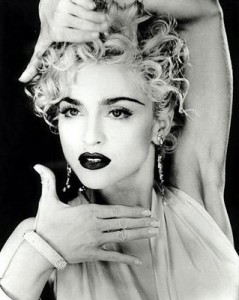 Summer is here and, much to my joy, videos are back! The confluence of Lady Gaga, Glee, OK GO, and You-Tube has reminded us of the great art form of the 1980s, the video, a four- to five-minute presentation of a lip-synched musical song in which dance-choreography was more often than not a crucial element. The video had elements of a copyrighted work (under Section 102 of the Copyright Act, it can comfortably be classified as audiovisual work), but more importantly than that, the video served as an extended commercial to prompt the viewer to go out and purchase the artist’s work.
Summer is here and, much to my joy, videos are back! The confluence of Lady Gaga, Glee, OK GO, and You-Tube has reminded us of the great art form of the 1980s, the video, a four- to five-minute presentation of a lip-synched musical song in which dance-choreography was more often than not a crucial element. The video had elements of a copyrighted work (under Section 102 of the Copyright Act, it can comfortably be classified as audiovisual work), but more importantly than that, the video served as an extended commercial to prompt the viewer to go out and purchase the artist’s work.
The video, though, at its greatest heights, was used by its more skilled practitioners to build and shape the individual artist’s persona beyond the popularity of any particular song. This often had the effect of strengthening the long-term commercial value of an artist’s work. I think, often, of the careers of Cyndi Lauper and Madonna as demonstrating the importance of this particular principle. Cyndi had the singing and writing chops (“Time After Time,” anyone?), but Madonna used the video art form to its maximum extent, making relevant her persona for over twenty-five years (yes, people, twenty-five years).
Thus, the video also invokes a more neglected sister of copyright, the right of publicity, which broadly protects the commercial value of a person’s identity.
A typical right of publicity statute, the Illinois Right of Publicity Act, grants the “right to control and to choose whether and how to use an individual’s identity for commercial purposes.” 765 Ill. Comp. Stat. 1075/10. While the right of publicity began as a narrow right to protect one’s name and likeness, it has often been interpreted by courts to protect other indicia of identity (most famously in Vanna White v. Samsung Electronics). Although the existence of the right of publicity often prompts questions about why we want to protect a person’s commercial identity (Paris Hilton, shudder), the video also prompts the question of exactly what identity does the right of publicity seek to protect?
The video era featured two great female video stars, Madonna and Janet Jackson, both of whom used the art form of the video to construct identity in different ways. Janet Jackson used the video to construct an “authentic” person in that she referenced a persona that did not shift from video to video (for example, go to You-Tube, take a look her “crowd” videos, “When I Think of You,” “Alright,” “Escapade,” and “That’s The Way Love Goes”). In each, Janet’s persona is much the same. She is an approachable individual, seeking love and enjoying friendship, amidst a series of different dancers (and if you were a Janet fan, you knew the names of Tish, Paula, and yes, J.Lo!). Janet even used her given name (“Ms. Jackson, if you are nasty!”). There were limits, however, to the authentic persona. In Janet’s case, Janet had to manage those details of her life that did not match the “authentic” Janet of the videos, and it appears that somewhere in the mid-90s, Janet tired of managing her “authentic” persona. Indeed, Janet often used her (less) successful music in the 2000s to question the validity of that “authentic” persona.
Madonna, by contrast, famously changed her persona often. Unlike Janet, she took another name, Madonna, rather than be Madonna Louise Veronica Ciccone from Michigan. Madonna then changed personas so frequently that any Madonna fan has their favorite Madonna persona (my favorite is Boho New York Early Eighties Borderline Madonna and Ray of Light Madonna). By my lights, one of the most effective scenes of Glee’s first season — of course, I am a Gleek! — was in its famous Madonna episode. The two leads dance to a mash-up of Open Your Heart/Borderline, as they walk through a high school of various Madonna personas — Like a Virgin Madonna, Vogue Madonna, Open Your Heart Madonna — to remind viewers of how many times she had changed. In a way, Madonna changed so much we knew she had become constant in, at least, the ability to change.
So, as these videos demonstrate, when we talk about identity as to the right of publicity, there is an open question. What is identity? As we define the right, should we only protect a person’s authentic identity (name, likeness, voice, etc.), or do we protect that constructed identity? Are Madonna’s many personas as valid as Janet’s one?

